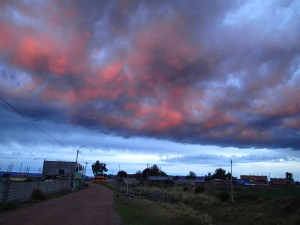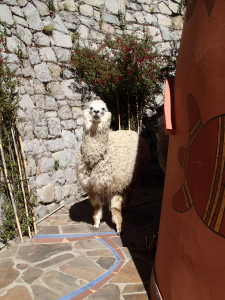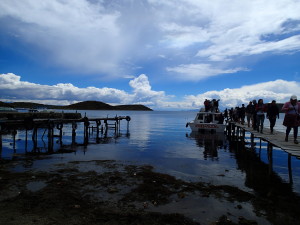Monday morning we left Cusco in good weather and drove towards Puno and the Bolivian border. Again we were expecting a long day with twisty roads up and down the mountain, but it was quite different: mostly flat grasslands, more and more indigenous farmers, again lots of animals and little villages with mud houses. We made it to Puno, a busy, dusty not very beautiful town and were stopped by police right away. For the first time we were asked to show our papers including insurance (which we didn’t have!)They were contend to see our Canadian insurance, after we claimed it was international! They bid us buen viaje and told us to be careful. Phew, last contact with the Peruvian police!
Just outside of Puno near Lake Titicaca we found a Hostel called Casa Blanca, which was almost in the middle of potato and corn fields as well as sheep pasture… so really nothing much. We were the only customers in a big 2 floor building. We negotiated a price with the Senora and since there was no place to eat anywhere near she said she was willing to cook supper for us. She proudly presented us a Spaghetti dinner with meatless sauce and shared the recipe (of course in fast Spanish!), she talked about her kids and everything. Seemed like she was happy to finally found someone who listened!!
She must have known that it was going to be a chilly night, because she also brought us another blanket. After a small breakfast next morning and our Senora strongly encouraging us to recommend her to our friends we said good bye. It was only a short ride to the Bolivian border. We braced ourselves for long waiting and paperwork. At first we met 3 german (from Bavaria!) guys on Motorcycles trying to enter into Peru…without insurance! They were kind of fed up with the officials, because they at first were refused entry. I think the worst you can do is to show your frustration and become visibly impatient, then the officials get really stubborn and will not do anything. Anyway they were lucky after a while and got through. For us it was a quick stamp out of ourselves and the bikes of Peru and off we went to the Bolivian side.
There we filled out the usual immigration paper, another customs officer filled out the paper for our bike, didn’t even go out to visibly check the bikes and…we were done! No hustle, barely any waiting time, no annoying people that want to help or change your money. Yeah, I liked that!
Off we went just about 8 km to Copacabana, a cute little town right on the shores of Lake Titicaca. We knew about another Hostel there called Las Olas. It has quirky, creative, individual “houses” with one big suite, bathroom and kitchenette, but the most phenomenal is the view. First we crinched at the price but then were able to lower it a bit. To say the truth it wasn’t cheap but we just couldn’t resist. It was situated on a hill overlooking the whole town and the Lake! Unfortunately we got the house on top, so had to walk numerous stairs up to it, which nearly choked me, since I was still fighting to breathe because of the altitude, but we had the best view!
For centuries Copacabana was the site for religious pilgrimages and today local and Peruvian pilgrims flock to its fiestas. There’s a beautiful Cathedral with the black “virgen de Candelaria” a statue carved by Francisco Yupanqui, the famous Inca Tupac Yupanqui’s grandson. We also visited the Horca del Inca site, which is a pre-Inca astronomical observatory. The odd trilithic gate perched on the hillside is surrounded by pierced rocks that permit the sun’s rays to pass through onto the lintel during the solstice of June 21, which is the Aymara New year. The Aymara and Quechua are indigenous people mostly located in the highlands.
We booked a ferry that took us to the Isla del Sol on the second day. This Island was supposedly the birthplace of the sun (hence the name) and also known to early inhabitants as Titi Khar’ka (Rock of the Puma) from which Titicaca takes its name. We walked from the north end (Cha’llapampa) to the south end (Yumani) in about 3 hours in over 4000m altitude over ancient pampas, which are still cultivated. You might think you’re on a greek island. There are no vehicles allowed ( the only “vehicle” is the donkey!) and again some Inca ruins to explore. At the north end there is apparently a “ciudad submergida”, a sunken city where in 2000 they found a massive stone temple, winding pathways and a surrounding wall, all about 8m under water and of Inca origin.
We arrived back in Copacabana late afternoon to find our Motorcycle friends Stewart and Will (the British guys) in front of our Hostel. Since they were following kind of in our tracks we left them a message earlier and invited them to stay in our “suite”, because we had 2 more beds we didn’t use anyway, and they had accepted. So they moved in with us for one night and marveled at our view.
Also on the ferry back to town Heinz was talking to another biker on a KLR, Brendan O’Toole (can you guess? An Irish fellow) who is on a solo ride to Patagonia. I should also mention that we ran into a Canadian couple the day before ( Rachel and Raphael, who is from Colombia!) and basically all decided to meet for supper on that night. So with this “international” group (Canada, England, Ireland, Colombia and…of course our German heritage, ha, ha!) we stormed a Bolivian Restaurant. It was a fun night and we all vowed to stay in touch. We had to run back to our Hostel in pouring rain and also found the rain leaking through the windows in our suite.
Next morning we met up with Brendan for breakfast, who proudly had found this place that served Irish breakfast with good soda bread. Indeed it was delicious and the Irish owner had a number of tips for the La Paz area for us!
We had decided to all ride together to the upcoming ferry at San Pedro de Tiquina, which would take us over the narrow Tiquina straits. We knew that those ferries were rather rafts and it might be a task to get the bikes onto it, so we wanted to be ready to help each other. Of course the three Stewart, Will and Brendan were no match for us being a lot slower than they were, but…hey everybody travels differently! Those rafts turned out to be a bit iffy, but with little effort we got them all on (and off!) safely. Stewart needed some brake pads in La Paz, Brendan wanted to follow Stewart and Will and we wanted to pass La Paz and find our next Hostel Colibri camping, 30 Min. south of the big city. So we said our good byes (again!) promised to stay in touch and to see if we might meet again for Christmas!
We all moved on and Heinz and I inched our way through La Paz. The famous Bolivian city that sits in a valley at 3660m altitude. We entered the city from above the hills through dusty unpaved roads and traffic chaos down into the valley with narrow streets, more traffic, markets and… more chaos, but on the other hand quite intriguing! We finally made it to Mallasa where our Hostel was located. We had no real address or GPS coordinates, just a vague idea, but at first could not find it. After we had to sit out a heavy down pour we tried again and stumbled over a little sign on the road so finally found the place. We are planning for 3 nights and want to explore the city of La Paz a bit tomorrow.
Feli





















